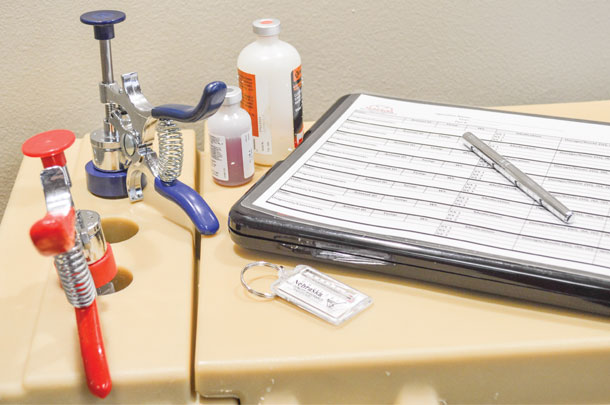We understand the importance of strong vaccination programs, proper diagnosis and treatment, and good stockmanship when handling livestock. The beef cattle community is committed to the best care and well-being of the animals entrusted to their care.
Many times, reading the label and proper handling of products used for prevention and treatment is overlooked. All animal health products have storage and handling information on the FDA label, whether they are vaccines or antimicrobials/antibiotics. It’s important to take a minute to review these labels each time you use or purchase them.
When handling vaccines, keeping them out of sunlight and in cool storage (35ºF to 45ºF) is common practice. When you store them prior to use, you should check your refrigerator is maintaining a proper temperature within the storage range on the label.
It is also recommended to store them in the center of the cooling area and not the door racks due to routine opening and closing of the door. Purchasing a simple thermometer to check temperatures can be a valuable tool.

When preparing to handle vaccines, keep a cooler with ice packs to ensure the proper temperature while processing cattle. There are a few companies designing coolers for cattlemen with locations for syringes and needles plus a cool storage area to place the product. You can also make your own with plastic foam or a small cooler drilled with a hole for syringes.
Antimicrobials/antibiotics are many times overlooked when it comes to storage and handling. Most can be stored at room temperature, but that temperature can vary by product. Checking labels on seven antibiotics used in beef cattle, there were five different storage claims: below 77ºF, below 86ºF, between 68ºF and 86ºF, between 59ºF and 86ºF, and between 59ºF and 77ºF.
Products can have different ranges of storage, so it is important to read and follow these labels to maintain effectiveness of the product when used judiciously for treatment. When transporting or carrying these products during routine livestock observation, use appropriate coolers to maintain these temperatures. A small cooler with a cool pack might be the best option.
In addition to storage, read and record lot numbers and expiration dates of all animal health products in your inventory. Some producers keep the box with this information, while others take a photograph for the information on their smart device. When purchasing any animal health product, consider the amount of product needed. Vaccines should be purchased as close to the amount needed as possible to ensure the product doesn’t expire before administration.
With antimicrobials, you need to consider the disease pressure or risk and how many diagnoses and treatments you may encounter in a given period of time. This can be difficult, as these risks can be and are unpredictable, so visiting with your veterinarian under a valid veterinarian-client-patient relationship is a first step. Purchasing smaller volumes might be best for your operation to again ensure product doesn’t expire before being used.
As a reminder, always follow BQA guidelines and labels when administering animal products. All injectables should be administered in the neck, use subcutaneous injection when possible, only administer 10 cc’s per injection location, use clean syringes and needles, and always follow FDA-approved labels. ![]()
PHOTO 1: Storage boxes can be purchased or crafted yourself for proper temperatures on vaccines and medicines.
PHOTO 2: Good vaccine storage tools include record lot numbers and expiration dates on all animal health products. Photos provided by Rob Eirich.
For more information on Nebraska BQA, visit online (Beef Quality Assurance Program).

-
Rob Eirich
- Nebraska Extension Beef Educator
- Director of Beef Quality Assurance
- Email Rob Eirich






